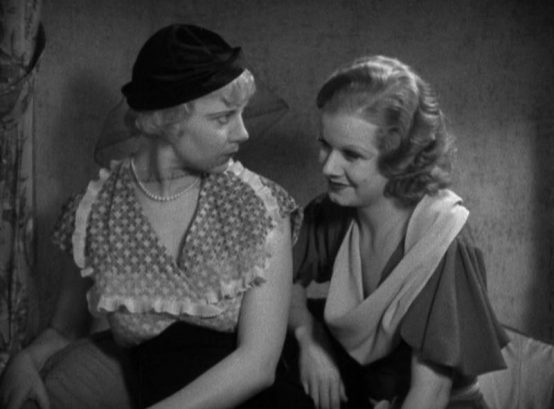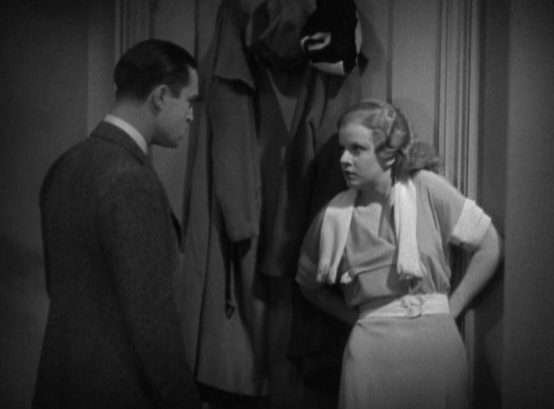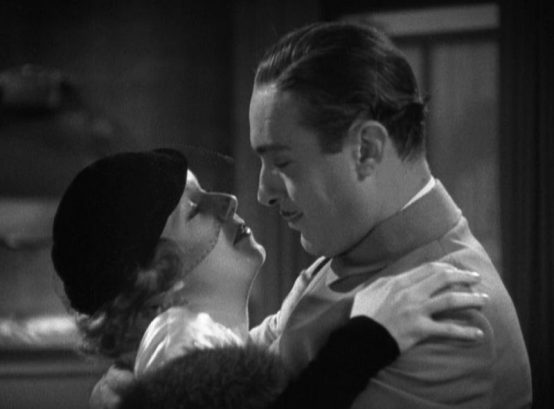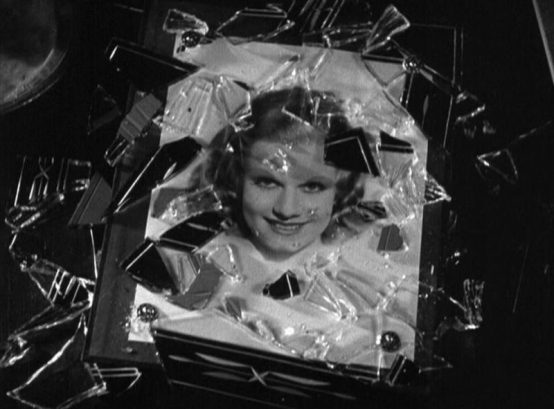I wrote this last year for The Pre-Code Companion, Issue #1. I’m republishing it on the site at this time with permission of Danny Reid, who edits and publishes the Pre-Code Companion series. The only changes to this version of the article are the addition of links, references, and my screen caps.
It was a bestseller, but so trashy that MGM couldn’t find a name actress willing to play the leading role. Clara Bow and Colleen Moore said no. Paramount refused MGM’s request of Nancy Carroll, RKO likewise when a test was requested of Helen Twelvetrees. The actress who eventually fought for and won the role, Jean Harlow, was most famous for her platinum blonde hair. She was notorious to movie fans for the wanton women she played on screen and notorious to critics and peers for her terrible acting. While established stars kept their distance from Red-Headed Woman and lesser known actresses, women as varied as Wynne Gibson, Dixie Lee, Lillian Roth, and Alice White, failed to win the part, Harlow rode it to reward and redemption, elevating herself and the film to legendary status.
Today Red-Headed Woman stands as an audacious example of sex in cinema during Hollywood’s remarkable pre-Code era. But the same movie also reminds us that there was a Production Code on the books when it was made, and a hired man overseeing the studios to keep them from going too far. Red-Headed Woman presented “a very grave problem” to Motion Picture Producers and Directors of America (MPPDA) President Will Hays, who saw its lead character, Lil Andrews, as no more than “a common little tart” and an “out-and-out harlot.” Lil Andrews was a part that may very well have ruined a more talented or established actress, but the lead actress, with a big assist from screenwriter Anita Loos, imbued Lil with so much of Harlow that she turned her into more than some tawdry attraction: she made her human.
“You’re too pretty and I don’t trust myself,” Bill Legendre Jr. (Chester Morris) tells his secretary, Lil Andrews (Harlow), who’s becoming a bit too familiar with him on his couch. Bill is a happily married man, his wife, Irene (Leila Hyams), is also his best friend who he grew up with. He never had any intention of cheating on her, but he never stood a chance against Lil. She hikes her skirt over her knees as she takes dictation, every inch of exposed flesh having the intended effect on her prey. This is no spur of the moment seduction for Lil. The girl from the wrong side of the tracks had long settled on Bill as her ideal catch. He’s handsome, cultured, has the right friends, the right position, and, oh yeah, he has money. She tells him she’s on his mind as much as he’s on hers. You can see Bill realize she’s right when Lil adds, “Before we even begin, you look me over. All over.” He tries to stop her, but once she kisses him, he barely makes an effort to fight her off. “I love my wife. I’ve never loved anyone else,” he pleads. He never had a chance.
Katherine Brush sold Red-Headed Woman to MGM in March 1931, before her story was even published. About a month later she sold serialization rights to the Saturday Evening Post for an amount variously reported as $40,000 to $50,000. New York publishing company Farrar and Rinehart released the novel in July 1931, and the Post ran its serialization in issues dated between August 22 and October 3, 1931. Red-Headed Woman by Katherine Brush wasn’t the bestselling novel of its time, but it was a bestseller. The book was a popular success during a Golden Age of reading. Lots of copies of it made the rounds, so Red-Headed Woman was a known quantity by the time it came to the screen.
The story sat for a time after MGM’s purchase, but its success for Brush guaranteed that the movie studio would find a way to overcome Production Code-head Will Hays’ objections. In late 1931 they began testing actresses to play the leading role, a hunt that seemingly attached itself to every up-and-coming young actress and starlet the studio could reach. There was little optimism when they tested Jean Harlow in New York on March 19, 1932. The twenty-one-year-old actress had previously caused a sensation on film, a couple of times, but while she was a natural for a ripe publicity campaign, Harlow was not considered a talented actress.
Notorious for her role in Hell’s Angels (1930) for Howard Hughes (“ Would you be shocked if I put on something more comfortable?”), and even more recently famed for her impossibly platinum hair in Columbia’s Platinum Blonde (1931)— the final title of a film originally called Gallagher after Hughes lobbied Columbia for a revision— Harlow could vamp and had looks, but had yet to carry a film based on her talent. “She was at that time, frankly, a non-pro,” said Mae Clarke, a Harlow co-star from The Public Enemy (1931) and Three Wise Girls (1932). “She wasn’t even talented. But she was beautiful”. Harlow had recently given her best performance to date as a seductive moll in MGM underworld film The Beast of the City (1932), an uncomplicated part that Harlow nonetheless aced with her most natural performance to date. After completing The Beast of the City, her stepfather and manager, Marino Bello, launched her on a public appearance tour across the East Coast of the United States. Harlow had just appeared in Baltimore when word came that she should get herself to New York to test for Red-Headed Woman.
A month after this screen test Harlow became MGM’s newest contract player, signed to the standard seven-year deal on April 20, 1932 with a salary beginning at $1,250 per week. The platinum blonde’s first stop was wardrobe, where she tried on a series of red wigs until coming upon the perfect fit for Lil Andrews. To make the story fit as well as the hair, Anita Loos, author of Gentleman Prefer Blondes, was called in to fix the muddled screenplay. MGM had previously hired F. Scott Fitzgerald to adapt Katherine Brush’s novel, but Red-Headed Woman was a work of popular fiction and would benefit from a less literary touch. Loos molded Lil Andrews to Harlow’s own personality, giving the actress the opportunity to play an exaggerated version of herself.
MGM contract director Jack Conway was assigned to the film. It was a solid choice. Conway had twenty years directorial experience at this time and was coming into his own with the talkies. He typically stood back and let the actors take over, as he had earlier in 1932 for the Barrymore brothers in Arsène Lupin. It was potentially a dangerous move given Harlow’s talent level, but the script had become such a reflection of the actress that she wound up commanding the spotlight. Later career highlights for Conway included Viva Villa! (1934) with Wallace Beery, A Tale of Two Cities (1935) with Ronald Colman, and several features starring Clark Gable, including Harlow’s swan song, Saratoga (1937).
Finishing touches on the script came after a sneak preview revealed that the original opening, introducing Lil on the attack, was too jarring. Loos added three short scenes before this that are such a bold introduction to both Lil Andrews and Jean Harlow that what follows almost doesn’t matter. The first moment of the film practically rewrites Harlow’s entire history to date, the former platinum blonde beaming up from a hairdresser’s chair, her hair, even in black-and-white, several shades darker than what we know it should be: “So gentlemen prefer blondes, do they?” she asks, Loos tying her own legacy to Harlow’s. “Yes, they do,” Lil adds, letting us know she’s got more working for her than hair color alone. Next scene, just a snippet of action, finds Lil trying on a dress, her entire body in the shot from head to toe as she asks, “Can you see through this?” We can’t, but we believe we can when an off-camera voice replies, “I’m afraid you can, Miss.” The confident Lil simply replies, “I’ll wear it.” If the audience wasn’t already reeling, the next scene focuses entirely on Lil’s calf, her dress hiked up high enough to reveal her garter as she slips a tiny photo of Chester Morris into a small, strategically placed mount. “The boss’s picture,” she says of Morris, soon introduced as Bill Legendre Jr. “Well,” she adds, “it will get me more there then it will hanging on the wall.”
With this introduction Red-Headed Woman is already such a shocker that takes some time for the audience to recover. Lil Andrews is bad, the type of woman your mother warned you about, either to stay away from or not to become. But she’s so brazen, so confident, and so self-assured, that it’s hard not to like her already. “The spicy passages are faintly touched with a sardonic tinge of elusive comedy,” Variety said, also noting, “Jean Harlow, hitherto not highly esteemed as an actress, gives an electric performance.” MGM had imagined so many actresses for the role, but all you have to do is watch the movie once for it to become impossible to separate Lil from Harlow. Throughout her obsessive pursuit of Bill, and then a later desire to upgrade, Harlow’s words from the opening, “So gentlemen prefer blondes, do they?” echo back at us. She’s not out for a gentleman, but far cagier game. And we want to root for her.
While Lil is busy seducing Bill, his wife, Irene (Hyams), decides to return home from her trip a night early, a decision mocked by Bill’s Aunt Jane (May Robson), who accompanies her: “Husbands just love being surprised.” As Irene drives towards home, Lil continues to work over Bill leading to a sort of reverse chase scene. We never anticipate a narrow escape, we anticipate confrontation. But the viewer pays witness to this first confrontation as if we were nosy neighbors peeking out our windows. Irene and Aunt Jane pull up in front of the house and say goodnight. Then Irene walks to the door and Aunt Jane drives away. Irene enters. Silence. The Legendre home presents a placid exterior, without hint of shouting or surprise from inside. Suddenly Lil races out of the house. She looks nervous, like a burglar caught just when she was making her final reach for the goods. Paused in front of the door with a hand to her face, Lil recovers her composure and runs away.
Despite Bill’s best intentions to distance himself from Lil, she’s absolutely mercenary in her chase. Lil infamously corners Bill in a phone booth when they both turn up at the same social club, no coincidence in itself. “Red, this is insane,” he tells her, but premeditation will never land you an insanity verdict. After word trickles through Lil’s pipeline that Bill and Irene have made-up, she drinks herself into such a state that she has no qualms about bursting into the Legendre living room and exposing the phone booth rendezvous, which sounds a lot worse for Bill than it really was. Irene is crushed, but Bill could probably still salvage the marriage. His temper destroys that opportunity as it lures him to Lil’s apartment, where he arrives fully intending to sever all ties with her. Instead he winds up in a furious sex-charged confrontation that he’s not strong enough to resist. The scene is highlighted by one of Harlow’s most famous moments on screen, as Bill tries to recover the confiscated key to Lil’s bedroom door and she taunts him until he loses control and smacks her across the face. Harlow is like a wild animal, completely untamed by this discipline, her voice breathless and excited as she demands, “Do it again, I like it! Do it again!” Bill’s sunk.
Now Bill’s wife, Lil now turns her attention to fitting in with the muckety-mucks, only to discover that society does not allow entrance through the back door. Perhaps Bill and Lil could have had a happily ever after had she been welcomed with open arms by his friends and family. But Bill’s friends are Irene’s friends, so Lil has no chance at contentment. She continues to plot, but Lil lacks the ammunition to win over the society women she wants to blend in with— obviously, sex will not work with them. A social pariah, Lil feels all she needs is opportunity. When one of the Legendre’s biggest business connections, Charles Gaerste (Henry Stephenson), comes to town and rebuffs her dinner invitation, Lil makes an incognito invasion of his hotel room. She seduces Gaerste and then uses his indiscretion to blackmail him into bringing his party, consisting entirely of Legendre connections, to her home. Never minding the marital infidelity, when Lil believes her party was a success she revels in the moment, content at last.
At least for a moment. Lil is never more honestly happy in Red-Headed Woman as when she rushes to Sally’s (Una Merkel) side upstairs—hidden away from Lil’s real guests—to tell her how well the evening went. It may have ended a little early, Lil explains, because everybody had to run home early to bed to rest up for a big charity function the next morning. “Are they all going to bed with Irene?” Sally asks. Told all of her guests are moving across the street to Irene’s house, Lil is heartbroken. Again, for just a moment. Harlow is many things in Red-Headed Woman, but for these few seconds she’s actually sweet. And then she sees fire.
“I’m through in this town,” she realizes, her rage propelling her downstairs, past Bill, who stands helpless alongside his father and Gaerste, as Lil parades across the street to tell off all of the people she had just been trying so hard to impress. “I’m through with the whole cheap hypocritical gang of you,” she declares, finally able to identify her cause as lost. Bill sweeps her up in his arms, leaving his friends to laugh even harder at Lil as he carries her back home like some little dog that yips too much.
Bill’s father puts his own plan into action towards ridding his son of this terrible woman. When originally shocked by Gaerste’s suggestion that they dine at Lil’s, Legendre Sr. discovered a handkerchief monogrammed with Lil’s initials that was left behind in his friend’s hotel room. Daddy Legendre knows exactly what Lil’s forgotten calling card implies, and he uses this knowledge to push Lil into Gaerste’s arms by financing her trip to New York. In New York, Lil uses the same tricks on Gaerste that she used to land Bill, only the bachelor Gaerste makes for an even easier prey. While Gaerste has even more money and power than Bill, he’s an older man, not as handsome nor as virile as Bill. Not satisfied, Lil also begins an affair with Gaerste’s chauffeur (Charles Boyer) that would no doubt spell her downfall in a typical movie ending.
Red-Headed Woman is not typical though. Even in most pre-Code films, a woman like Lil may run roughshod over men for most of the movie, but typically they’re going to pay in the end with death or ruination. Not our Lil.
Even after proving herself a sociopath through an unexpected bit of gunplay at the film’s climax (one of the only sour notes of the film), Lil gets to win in the end. Her only punishments are time and exile. Her victory must wait two years and come overseas, far away from Renwood and the Legendres. Repeating her Gaerste gambit, Lil manages to become an adored society figure in France, much to the amusement of the male Legendres who spot her during their vacation. A final wink is provided as Lil grabs the arm of her elder French lover, piles into the back of the car and gives orders to her smiling chauffeur, the same man who drove for Gaerste. That conclusion must have dropped a few jaws just as the theater lights came on!
Critics praised the film and praised Harlow, but couldn’t quite believe what they were seeing. Hollywood Filmograph wondered “what it will be like after the censors have red-penciled it,” warning film exhibitors that “it seems pretty safe box-office advice that the red-pencil will devastate the Red Headed Woman.” Motion Picture Herald agreed in its review, also targeted to the motion picture houses: “Undoubtedly the censor boards will tone down some of the more torrid scenes, but even so, there will be plenty left to stir up the long-haired moral guardians of your community.” That was certainly the case in Pittsburgh, where the censors let the film open without incident, but then went back to chop off ten minutes of running time before playing Red-Headed Woman again. It’s worth noting that the preview version of Red-Headed Woman reviewed for film exhibitors was listed with a 75-minute running time. The version we currently have on DVD in Volume 1 of the Forbidden Hollywood Collection runs 79-minutes, the likely difference in time being the opening montage of sin that Anita Loos added after the preview. Otherwise viewers in 1932 were likely seeing exactly the film we get to enjoy today. Outside of Pittsburgh at least.
Red-Headed Woman was a hit in its day, grossing over three-quarters three-quarters of a million dollars after an outlay of just over $400,000 (Stenn 88). It revealed a new Jean Harlow to moviegoers, one that MGM quickly doubled down on by starring opposite Clark Gable in her next film, the every bit as daring Red Dust (1932). By the time Red-Headed Woman was released Harlow had married the man most responsible for getting her the job, producer Paul Bern. Within a few months she was in the midst of controversy when one of Hollywood’s most notorious scandals unfolded with Bern’s suicide, while Red Dust was still in production. Harlow’s stardom forever became charged with a similar notoriety that made her a legend even in her own, sadly brief, time.
Red-Headed Woman is part of the first Forbidden Hollywood DVD Collection. Now out-of-print, you can pick up new and used copies from third-party sellers at collectible prices at Amazon.com (be sure to read those condition notes and seller reviews before purchasing!). You might do a little better on eBay
with this one.
References
- Aswell, James. “My New York.” New Castle Pa. News, September 9, 1931, 10.
- Brush, Katharine. Red-Headed Woman. New York: International Readers League, 1931.
- “Can’t Find Red Head.” Variety, December 8, 1931, 11.
- Curtis, James. Featured Player: An Oral Autobiography of Mae Clarke. Lanham MD: Scarecrow Press, 1996.
- Dickstein, Martin. “The Cinema Circuit.” Brooklyn Daily Eagle, March 19, 1931, 23.
- Gilbert, D.W. “Review: Red-Headed Woman.” Hollywood Filmograph, June 18, 1932, 5.
- “Harlow as Redhead.” Film Daily, April 28, 1932, 2.
- “Inside Stuff-Pictures.” Variety, July 19, 1932, 50.
- McIntyre, O.O. “Dreaming by the Old Water Hole.” Hamilton Daily News, April 25, 1931, 15.
- “Review: Red-Headed Woman.” Variety, July 5, 1932, 14.
- “Showmen’s Reviews: Red-Headed Woman.” Motion Picture Herald, June 25, 1932, 25.
- Stenn, David. Bombshell: The Life and Death of Jean Harlow. New York: Doubleday, 1993.
- “Still Hunting Redhead.” Film Daily, February 28, 1932, 5.
- “Story Purchases.” Motion Picture Herald, April 25, 1931, 78.
- “The Literary Almanac.” Salt Lake Tribune, July 5, 1931, 3.
I wrote this last year for The Pre-Code Companion, Issue #1. I’m republishing it on the site at this time with permission of Danny Reid, who edits and publishes the Pre-Code Companion series. The only changes to this version of the article are the addition of links, references, and my screen caps.














Don’t know why,I never “got her” and she’s one of the few stars that I have to immediately change the channel when she’s on.not overly attractive,a bit of a loud mouth, not sure what many see.
Ron, have you see this particular title because ‘loud mouth’ fits her character well here, so it might be a fit for you. I enjoy her from this time until the end, but she grates on me in her earlier movies before her skill had caught up to her screen presence. So, I get what you’re saying: I’m not a fan of her appearance in The Public Enemy for instance, but find that she earns every bit of her rep in something like Red-Headed Woman. Thanks for commenting!